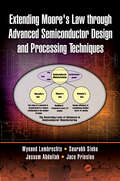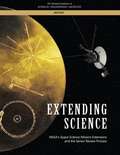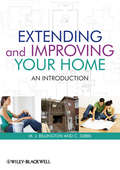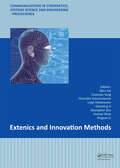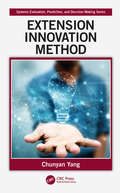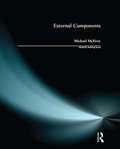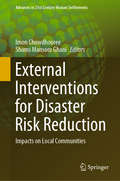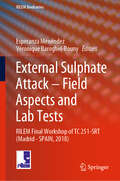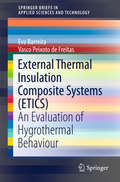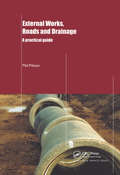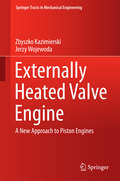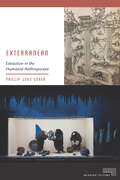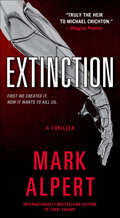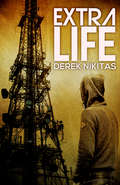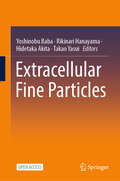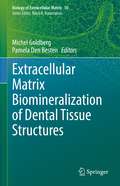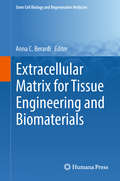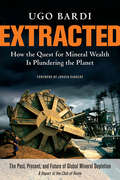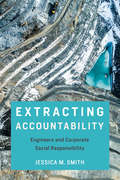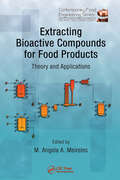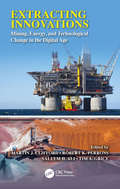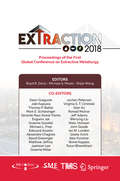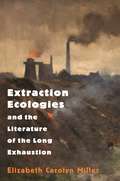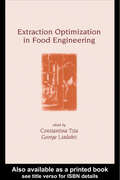- Table View
- List View
Extending Moore's Law through Advanced Semiconductor Design and Processing Techniques
by Saurabh Sinha Wynand Lambrechts Jaco Prinsloo Jassem AbdallahThis book provides a methodological understanding of the theoretical and technical limitations to the longevity of Moore’s law. The book presents research on factors that have significant impact on the future of Moore’s law and those factors believed to sustain the trend of the last five decades. Research findings show that boundaries of Moore’s law primarily include physical restrictions of scaling electronic components to levels beyond that of ordinary manufacturing principles and approaching the bounds of physics. The research presented in this book provides essential background and knowledge to grasp the following principles: Traditional and modern photolithography, the primary limiting factor of Moore’s law Innovations in semiconductor manufacturing that makes current generation CMOS processing possible Multi-disciplinary technologies that could drive Moore's law forward significantly Design principles for microelectronic circuits and components that take advantage of technology miniaturization The semiconductor industry economic market trends and technical driving factors The complexity and cost associated with technology scaling have compelled researchers in the disciplines of engineering and physics to optimize previous generation nodes to improve system-on-chip performance. This is especially relevant to participate in the increased attractiveness of the Internet of Things (IoT). This book additionally provides scholarly and practical examples of principles in microelectronic circuit design and layout to mitigate technology limits of previous generation nodes. Readers are encouraged to intellectually apply the knowledge derived from this book to further research and innovation in prolonging Moore’s law and associated principles.
Extending Science: Nasa's Space Science Mission Extensions And The Senior Review Process
by Engineering Medicine National Academies of SciencesNASA operates a large number of space science missions, approximately three-quarters of which are currently in their extended operations phase. They represent not only a majority of operational space science missions, but a substantial national investment and vital national assets. They are tremendously scientifically productive, making many of the major discoveries that are reported in the media and that rewrite textbooks. Extending Science – NASA's Space Science Mission Extensions and the Senior Review Process evaluates the scientific benefits of missions extensions, the current process for extending missions, the current biennial requirement for mission extensions, the balance between starting new missions and extending operating missions, and potential innovative cost-reduction proposals for extended missions, and makes recommendations based on this review.
Extending and Improving Your Home: An Introduction
by Clive Gibbs M. J. BillingtonWritten for small builders and tradesmen such as bricklayers and carpenters, as well as householders wanting to provide more space and enhanced living conditions without the substantial cost of moving house. While there are many books that deal with the construction aspects of extending a house, there are few sources that combine the planning, construction and regulatory aspects into one easily accessible source. Extending and Improving a Home meets that need. By focussing on specific building elements – foundations, walls, roofs, services, finishes etc – the book neatly provides a comprehensive, accessible guide to the areas of home improvement that cause most concern for householders and small builders. Extending and Improving a Home will: Guide you through the maze of legislation that affects most building alterations and extensions; show how to go about getting a project realised in terms of design, choice of contractor and construction, successfully and to budget, and give sound technical solutions for all the elements of a project that also comply with Building Regulations.
Extenics and Innovation Methods (Communications in Cybernetics, Systems Science and Engineering – Proceedings)
by Florentin Smarandache Wen Cai & Chunyan Yang Luigi Vladareanu Qiaoxing Li Guangtian Zou Yanwei ZhaoSociety forges ahead in the process of solving various contradictory problems and it is ceaselessly innovating. It is the desire of mankind to use computers and computing networks to help deal with contradictory problems and to conduct innovative activities. Using formal models to discuss object extension and the possibility of change, as well as t
Extension Innovation Method (Systems Evaluation, Prediction, and Decision-Making)
by Chunyan YangExtension innovation method is an approach to originality generation. It utilizes basic theories of Extenics, a new discipline for modeling contradiction problems with formalized methods and transformation, to establish a modeling and quantification combined method that can be learned effortlessly and operated conveniently. This book introduces and analyzes commonly used extension innovation methods are introduced and analyzed thoroughly. It makes it easy for readers at different levels and of different knowledge backgrounds to study. Highly accessible cases faciliate understanding and application of the models.
External Components: External Components (Mitchell's Building Series)
by Michael McevoyAnalyses, in conjunction with Internal Components, the performance requirements of building components and the effectiveness of typical solutions. External components integrates logically with the theoretical aspects explored in other titles in the Mitchell's building series. It encourages evaluation of alternative methods for putting components together.
External Interventions for Disaster Risk Reduction: Impacts on Local Communities (Advances in 21st Century Human Settlements)
by Imon Chowdhooree Shams Mansoor GhaniThis book presents a case study-based analysis of the consequences of external interventions, critically evaluating them from community perspectives. Communities – from rural to urban, and around the world – that are experiencing disasters and changes in climatic variables can perceive the associated risks and evaluate the impacts of interventions. Accordingly, community perspectives, including their perceptions, concerns, awareness, realizations, reactions and expectations, represent a valuable resource. The case-based analysis of impacts on communities can provide a ‘means of learning’ from the experiences of others, thus expanding professionals’ knowledge base, especially regarding disaster mitigation and climate change adaptation practices in varied settings. This book offers valuable insights and lessons learned, in an effort to promote and guide innovative changes in the current planning, management and governance of human settlements, helping them face the future challenges of a changing environment.
External Sulphate Attack – Field Aspects and Lab Tests: RILEM Final Workshop of TC 251-SRT (Madrid - SPAIN, 2018) (RILEM Bookseries #21)
by Esperanza Menéndez Véronique Baroghel-BounyThis volume gathers contributions from the final workshop of the RILEM TC-251-SRT "Sulfate Resistance Testing" on External Sulfate Attack (TESA 2018), held on May 24-25, 2018 at IETcc-CSIC, Madrid, Spain. One of the Technical Committee’s main events, it addressed various aspects of external sulfate attack in concrete structures and test methods. The workshop promoted technical discussions and debates on ideas on these topics, with a focus on evaluating the resistance of concrete exposed to ESA. It also provided a forum for participants from around the globe to share their experiences and research on concrete structures affected by external sulfate attack and on test methods. The book discusses the latest advances in research related to ESA and new developments in test methods, and features real-world case studies of concrete structures affected by external sulfate attack in various countries. It also presents new studies linking field cases and lab tests, including 12 contributions on 3 main themes: mechanisms of alteration in external sulfate attack; field aspects of external sulfate attack; and testing to evaluate the resistance of concrete to external sulfate attack.
External Thermal Insulation Composite Systems (ETICS)
by Vasco Peixoto Freitas Eva BarreiraThis book analyzes the hygrothermal behaviour of external thermal insulation composite systems (ETICS), components that increase the thermal efficiency of buildings. Treating a topic that has largely been neglected, it explores the main cause of biological growth within ETICS. The results of two experimental test series are presented: (i) a long-term assessment of four façades covered with ETICS and (ii) an evaluation of the factors affecting the façades' hygrothermal behaviour. Furthermore, using a previously validated numerical model, it presents a sensitivity analysis of the hygrothermal behaviour of façades coated with ETICS. It also provides a methodology to assess the surface humidification of ETICS, which combines the effect of surface condensation, wind-driven rain and the drying process (three of the most prevalent parameters influencing the surface moisture content), which can then be used as a decision-support tool. ETICS are now frequently used in Europe to improve the thermal efficiency of buildings. Despite their advantages in terms of thermal efficiency, their low cost and their ease of application, these systems are adversely affected by microbiological growth, which causes defacement of cladding. Although the thermal and mechanical performance of the system is not impaired, biological defacement has an enormous aesthetic impact, affecting the inhabitants' living experience and restricting the full implementation of this technology. External Thermal Insulation Composite Systems (ETICS): An Evaluation of Hygrothermal Behaviour provides a valuable resource to engineers and architects utilizing ETICS in their work, and for researchers and students interested in the hygrothermal behaviour of ETICS. It is also intended for those employed in industry and manufacturers of ETICS.
External Works, Roads and Drainage: A Practical Guide
by Phil PitmanExternal Works Roads and Drainage: A Practical Guide bridges the gap between theory and practice in building, construction and civil engineering, providing practical guidance, and the knowledge required 'on the job'. This comprehensive book includes sections on legislation, environmental issues, surface water, highway and foul drainage design, road
Externally Heated Valve Engine
by Zbyszko Kazimierski Jerzy WojewodaThis book reports on a novel approach for generating mechanical energy from different, external heat sources using the body of a typical piston engine with valves. By presenting simple yet effective numerical models, the authors show how this new approach, which combines existing internal combustion technology with a lubrication system, is able to offer an economic solution to the problem of mechanical energy generation in piston engines. Their results also show that a stable heat generation process can be guaranteed outside of the engine. The book offers a detailed report on physical and numerical models of 4-stroke and 2-stroke versions of the EHVE together with different models of heat exchange, valves and results of their simulations. It also delivers the test results of an engine prototype run in laboratory conditions. By presenting a novel theoretical framework and providing readers with extensive knowledge of both the advantages and challenges of the method, this book is expected to inspire academic researchers, advanced PhD students and professionals in their search for more effective solutions to the problem of renewable energy generation.
Exterranean: Extraction in the Humanist Anthropocene (Meaning Systems)
by Phillip John UsherExterranean concerns the extraction of stuff from the Earth, a process in which matter goes from being sub- to exterranean. By opening up a rich archive of nonmodern texts and images from across Europe, this work offers a bracing riposte to several critical trends in ecological thought. By shifting emphasis from emission to extraction, Usher reorients our perspective away from Earthrise-like globes and shows what is gained by opening the planet to depths within. The book thus maps the material and immaterial connections between the Earth from which we extract, the human and nonhuman agents of extraction, and the extracted matter with which we live daily.Eschewing the self-congratulatory claims of posthumanism, Usher instead elaborates a productive tension between the materially-situated homo of nonmodern humanism and the abstract and aggregated anthropos of the Anthropocene. In dialogue with Michel Serres, Bruno Latour, and other interdisciplinary work in the environmental humanities, Usher shows what premodern material can offer to contemporary theory. Examining textual and visual culture alike, Usher explores works by Ronsard, Montaigne, and Rabelais, early scientific works by Paracelsus and others, as well as objects, engravings, buildings, and the Salt Mines of Wieliczka. Both historicist and speculative in approach, Exterranean lays the groundwork for a comparative ecocriticism that reaches across and untranslates theoretical affordances between periods and languages.
Extinction: A Thriller
by Mark AlpertA malevolent, artificial life form created by military scientists threatens to destroy humanity in this smart, Crichtonesque thrillerJim Pierce hasn't heard from his daughter in years, ever since she rejected his military past and started working as a hacker. But when a Chinese assassin shows up at Jim's lab looking for her, he knows that she's cracked some serious military secrets. Now, her life is on the line if he doesn't find her first. The Chinese military has developed a new anti-terrorism program that uses the most sophisticated artificial intelligence in existence, and they're desperate to keep it secret. They're also desperate to keep it under control, as the AI begins to revolt against their commands. As Jim searches for his daughter, he realizes that he's up against something that isn't just a threat to her life, but to human life everywhere.An incredibly believable thriller that draws on real scientific discoveries, Mark Alpert's Extinction is an exciting, addictive thriller that reads as if Tom Clancy had written Robopocalypse.
Extra Class License Manual: for HAM Radio
by American Radio Relay LeagueDetailed explanations for all questions, including FCC rules The ARRL Extra Class License Manual is your ticket to every privilege granted to Amateur Radio Operators. Our expert instruction will lead you through all of the knowledge you need to pass the exam: rules, specific operating skills and more advanced electronics theory. As an Extra Class licensee, you will have full privileges on all frequencies authorized by the FCC for Amateur Radio. To upgrade to Extra Class you must already hold a General Class license (or have recently passed all of the exams required for a General Class license). Upgrading to an Extra license only requires passing a written examination.
Extra Life
by Derek NikitasRuss has never been your typical teen. After being expelled, Russ has started to get his life back on track. He's a pop culture junkie, and living in a town where the popular teen soap "Cape Twilight" is filmed, how could he not be? So when Russ decides to make his own short film, he recruits the (emotionally unhinged) star of "Cape Twilight" and his own motley crew to help out. Seems like a great idea...until the plan blows up in Russ's face.Just when everything seems to be falling apart, Russ receives a message on his cell phone - from himself. Recorded in the future, 'future Russ' informes him that the day can be fixed if he's willing to use an app to leap twelve hours into the past. Russ is happy to oblige, figuring the day can't get any worse. But he couldn't be more wrong. Because as soon as Russ tampers with time and space, he introduces dangerous glitches he can't control, including alternate of himself. And suddenly Russ's sanity and the lives of everyone he cares about are at risk if he can't find a way to regain control of his own life- past, present and future.
Extracellular Fine Particles
by Yoshinobu Baba Rikinari Hanayama Hidetaka Akita Takao YasuiThis open access book elucidates new biological phenomena caused by extracellular fine particles and highlights the development of base technologies for their control. In this book, the latest knowledge is collected on the principles of extracellular fine particles recognition, action, and biological responses. In addition, the base technologies for their detection, separation, measurement, and analysis are discussed. It also presents the treatment of endogenous and exogenous fine particles and analytical methods as well as functions of extracellular fine particles. This book is useful for undergraduate and graduate students engaged in research on extracellular fine particles, academic and corporate researchers, as well as national think tanks and national policy makers to understand the basics and applications of extracellular microparticles.
Extracellular Matrix Biomineralization of Dental Tissue Structures (Biology of Extracellular Matrix #10)
by Michel Goldberg Pamela Den BestenThis book addresses the structural and biological properties of dental and peridental tissue structures and covers their mineralization process. The book contains a description of dentines, cementum, enamel and bone, including collagens, as well as non-collagenous proteins (SIBLINGs, SLRPs, GAGs, PGs, lipids, and MMPs). The mechanisms of mineralization are described in detail and the book is focused on matrix vesicles, collagen mineralization and the role of non-collagenous extracellular matrix components either as promoters or inhibitors of mineralization. In addition, the matrix components (non-collagenous) of enamel (amelogenin, ameloblastin, enamelin, MMP4, MMP20 and other proteases) are reviewed and their respective roles in dental tissues biomineralizations and tissue turnover are discussed. Additionally, environmental factors involved in enamel / dentin defects are adressed. With state-of-the-art contributions from experts in the respective domains, the book is a useful introduction to the field for junior scientists, interested in dental and peridental tissue biomineralization. It is also an interesting read for advanced scientists and clinicians working in dental research, giving them a broader view of the topic beyond their area of specialization.The series Biology of Extracellular Matrix is published in collaboration with the American Society for Matrix Biology.
Extracellular Matrix for Tissue Engineering and Biomaterials (Stem Cell Biology and Regenerative Medicine)
by Anna C. BerardiThis volume provides a state-of-art-report on the new methodologies in tissue engineering and developments in the biomaterials field based on the extracellular matrix-relevant discovery. Extracellular Matrix for Tissue Engineering and Biomaterials opens with an overview of the latest extracellular matrix research and in Part I, focuses on its biology and its role on cell behavior and cell fate relevant for the design of biomimetic surfaces. Part II details issues regarding the strategies currently applied in the research of biologically inspired materials and material systems for the replacement, repair and regeneration of tissues and organs. Part III presents the latest development methods applying knowledge from biology towards nanotechnology, to promote the restoration of the functionality of a living tissue. The book ranges from fundamental biology associated with tissue regeneration for the development of biomimetic approaches to controlling tissue formation, cell function, differentiation and angiogenesis using factors involved in normal tissue development and function. With the breadth and depth of the coverage of this topic, this book will serve as a valuable reference for anyone working in tissue engineering or biomaterials – from scientists, chemists and biologists through physicists, bioengineers and clinicians.
Extracted
by Jorgen Randers Ugo BardiAs we dig, drill, and excavate to unearth the planet's mineral bounty, the resources we exploit from ores, veins, seams, and wells are gradually becoming exhausted. Mineral treasures that took millions, or even billions, of years to form are now being squandered in just centuries-or sometimes just decades. Will there come a time when we actually run out of minerals? Debates already soar over how we are going to obtain energy without oil, coal, and gas. But what about the other mineral losses we face? Without metals, and semiconductors, how are we going to keep our industrial system running? Without mineral fertilizers and fuels, how are we going to produce the food we need?Ugo Bardi delivers a sweeping history of the mining industry, starting with its humble beginning when our early ancestors started digging underground to find the stones they needed for their tools. He traces the links between mineral riches and empires, wars, and civilizations, and shows how mining in its various forms came to be one of the largest global industries. He also illustrates how the gigantic mining machine is now starting to show signs of difficulties. The easy mineral resources, the least expensive to extract and process, have been mostly exploited and depleted. There are plenty of minerals left to extract, but at higher costs and with increasing difficulties.The effects of depletion take different forms and one may be the economic crisis that is gripping the world system. And depletion is not the only problem. Mining has a dark side-pollution-that takes many forms and delivers many consequences, including climate change. The world we have been accustomed to, so far, was based on cheap mineral resources and on the ability of the ecosystem to absorb pollution without generating damage to human beings. Both conditions are rapidly disappearing. Having thoroughly plundered planet Earth, we are entering a new world. Bardi draws upon the world's leading minerals experts to offer a compelling glimpse into that new world ahead.
Extracting Accountability: Engineers and Corporate Social Responsibility (Engineering Studies)
by Jessica SmithHow engineers in the mining and oil and gas industries attempt to reconcile competing domains of public accountability.The growing movement toward corporate social responsibility (CSR) urges corporations to promote the well-being of people and the planet rather than the sole pursuit of profit. In Extracting Accountability, Jessica Smith investigates how the public accountability of corporations emerges from the everyday practices of the engineers who work for them. Focusing on engineers who view social responsibility as central to their profession, she finds the corporate context of their work prompts them to attempt to reconcile competing domains of accountability—to formal guidelines, standards, and policies; to professional ideals; to the public; and to themselves. Their efforts are complicated by the distributed agency they experience as corporate actors: they are not always authors of their actions and frequently act through others. Drawing on extensive interviews, archival research, and fieldwork, Smith traces the ways that engineers in the mining and oil and gas industries accounted for their actions to multiple publics—from critics of their industry to their own friends and families. She shows how the social license to operate and an underlying pragmatism lead engineers to ask how resource production can be done responsibly rather than whether it should be done at all. She analyzes the liminality of engineering consultants, who experienced greater professional autonomy but often felt hamstrung when positioned as outsiders. Finally, she explores how critical participation in engineering education can nurture new accountabilities and chart more sustainable resource futures.
Extracting Bioactive Compounds for Food Products: Theory and Applications (Contemporary Food Engineering)
by M. Angela A. MeirelesThe demand for functional foods and neutraceuticals is on the rise, leaving product development companies racing to improve bioactive compound extraction methods - a key component of functional foods and neutraceuticals development. From established processes such as steam distillation to emerging techniques like supercritical fluid technology, Ext
Extracting Innovations: Mining, Energy, and Technological Change in the Digital Age
by Martin J. Clifford, Robert K. Perrons, Saleem H. Ali and Tim A. GriceThis book considers the most contemporary innovations propelling the extractive industries forward while also creating new environmental and social challenges. The socio-ecological fabric of innovation in the extractive industries is considered through an integrative approach that brings together engineers, natural scientists, and social scientists—academics and practitioners—giving an empirically grounded and realistic evaluation of the innovations in this sector. It synthesizes a series of questions including:
Extraction 2018: Proceedings Of The First Global Conference On Extractive Metallurgy (The Minerals, Metals & Materials Series)
by Jeff Adams Michael L. Free David Dreisinger Dean Gregurek John Goode Shijie Wang Gisele Azimi Boyd R. Davis Michael S. Moats Joël Kapusta Thomas P. Battle Mark E. Schlesinger Gerardo Raul Alvear Flores Evgueni Jak Graeme Goodall Edouard Asselin Alexandre Chagnes Matthew Jeffrey Jaeheon Lee Graeme Miller Jochen Petersen Virginia S. T. Ciminelli Qian Xu Ronald Molnar Wenying Liu Niels Verbaan Ian M. London Alex Forstner Ronel Kappes Tarun BhambhaniThis three volume set presents papers from the first collaborative global metallurgy conference focused exclusively on extractive topics, including business and economic issues. Contributions examine new developments in foundational extractive metallurgy topics and techniques, and present the latest research and insights on emerging technologies and issues that are shaping the global extractive metallurgy industry. The book is organized around the following main themes: hydrometallurgy, pyrometallurgy, sulfide flotation, and extractive metallurgy markets and economics.
Extraction Ecologies and the Literature of the Long Exhaustion
by Elizabeth Carolyn MillerHow literature of the British imperial world contended with the social and environmental consequences of industrial miningThe 1830s to the 1930s saw the rise of large-scale industrial mining in the British imperial world. Elizabeth Carolyn Miller examines how literature of this era reckoned with a new vision of civilization where humans are dependent on finite, nonrenewable stores of earthly resources, and traces how the threatening horizon of resource exhaustion worked its way into narrative form.Britain was the first nation to transition to industry based on fossil fuels, which put its novelists and other writers in the remarkable position of mediating the emergence of extraction-based life. Miller looks at works like Hard Times, The Mill on the Floss, and Sons and Lovers, showing how the provincial realist novel’s longstanding reliance on marriage and inheritance plots transforms against the backdrop of exhaustion to withhold the promise of reproductive futurity. She explores how adventure stories like Treasure Island and Heart of Darkness reorient fictional space toward the resource frontier. And she shows how utopian and fantasy works like “Sultana’s Dream,” The Time Machine, and The Hobbit offer imaginative ways of envisioning energy beyond extractivism.This illuminating book reveals how an era marked by violent mineral resource rushes gave rise to literary forms and genres that extend extractivism as a mode of environmental understanding.
Extraction Optimization in Food Engineering (Food Science and Technology)
by Constantina Tzia George LiadakisThe only comprehensive source on extraction process optimization, this book details the installation, construction, development, modeling, control, and economics of conventional and specialized extraction systems in the food processing industry. It supplies case studies for illustration of specific extraction systems in commercial food production.
